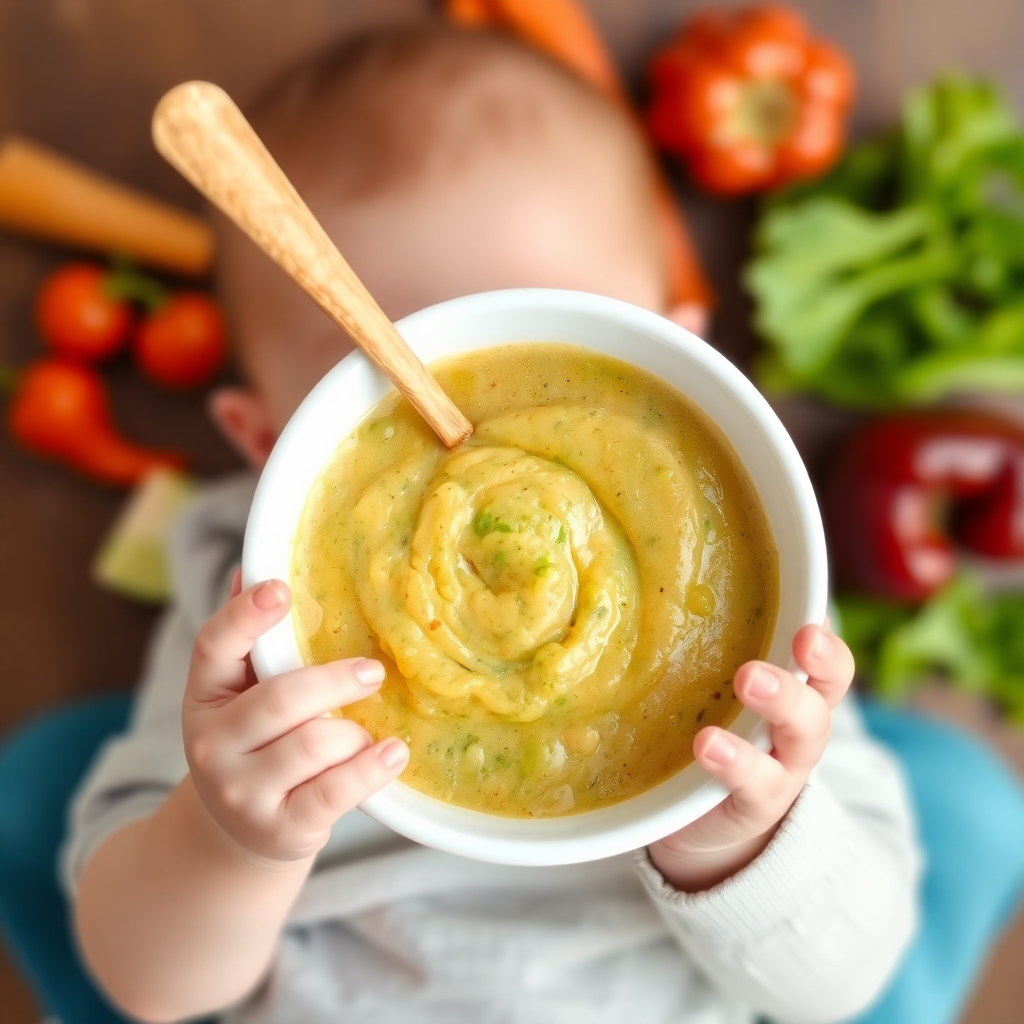Starting solids at 6 months is an exciting step in your baby’s development. Breast milk or formula remains the primary source of nutrition at this age, but small amounts of solid food help them explore new tastes and textures. Parents often wonder how much food is enough. Should you follow a strict portion size or trust your baby’s hunger cues? This guide covers everything you need to know—from portion sizes to feeding schedules—so you can confidently introduce solids. Understanding your baby’s needs will make mealtime enjoyable and stress-free for both of you. Let’s dive into the details!
Why do Solid Foods start at 6 Months?
At 6 months, babies are developmentally ready for solid foods. Their digestive system has matured enough to handle more than just breast milk or formula. Around this age, babies also develop better tongue control, allowing them to move food around in their mouths and swallow safely. Additionally, their natural iron stores from birth start to decrease, making iron-rich foods essential for healthy growth.
Introducing solids at this stage helps babies explore different textures and flavors, promoting better eating habits in the future. It also supports oral and motor skill development, which is crucial for speech and chewing later on. Waiting until 6 months reduces the risk of choking and food allergies, ensuring a smoother transition to solid foods.
While solid foods become an essential part of their diet, breast milk or formula should still provide most of their nutrition during this phase. Starting at the right time makes mealtime enjoyable and beneficial for your baby’s health.
Signs Your Baby is Ready for Solid Foods

Every baby develops at their own pace, but most are ready for solid foods around 6 months. Here are key signs that indicate your baby is prepared to start solids:
1. Good Head and Neck Control
Your baby should be able to hold their head steady and sit upright with little support. This helps them swallow food safely.
2. Loss of Tongue Thrust Reflex
Babies naturally push objects out of their mouths with their tongues. If this reflex has faded, they can move food to the back of their mouth and swallow properly.
3. Interest in Food
Does your baby watch you eat, reach for your food, or open their mouth when you bring food near? This curiosity means they’re ready to explore new tastes and textures.
4. Ability to Open Mouth for a Spoon
If your baby willingly opens their mouth when offered a spoon, it’s a good sign they’re ready to eat solids.
5. Increased Appetite
If your baby still seems hungry even after regular breast milk or formula feedings, they may need additional nutrition from solids.
How Much Baby Food Should a 6-Month-Old Eat?
Introducing solids at 6 months is all about exploration rather than full meals. Your baby’s primary nutrition still comes from breast milk or formula, but small portions of solids help them adjust to new flavors and textures.
General Guidelines for Portion Sizes
At 6 months, babies typically eat:
- 1–2 tablespoons of a single-ingredient puree per meal
- 1–2 meals of solid food per day
- 4–6 ounces of breast milk or formula per feeding (around 24–32 ounces daily)
Start with small portions and gradually increase based on your baby’s interest and tolerance. Offer one new food at a time to check for allergies or sensitivities.
Understanding Baby’s Hunger Cues
Babies naturally signal when they’re hungry or full. Look for these signs:
- Hunger Signs: Opening mouth, leaning forward, reaching for food, sucking on hands
- Fullness Signs: Turning head away, closing mouth, pushing food away, losing interest
Always follow your baby’s lead. Forcing food can create negative associations, while responsive feeding encourages healthy eating habits. Solids should complement—not replace—breast milk or formula at this stage.
Types of Foods to Introduce

At 6 months, your baby is ready to explore different textures and flavors. Start with soft, easy-to-digest foods and gradually introduce a variety of nutrients to support growth and development.
Best First Foods for a 6-Month-Old
Begin with single-ingredient purees to monitor any allergic reactions. Here are great options:
- Iron-Rich Foods: Fortified baby cereals (oatmeal, rice), pureed meats (chicken, turkey), lentils
- Fruits: Mashed bananas, applesauce, pureed pears, peaches
- Vegetables: Pureed carrots, sweet potatoes, squash, peas
- Dairy: Small amounts of plain yogurt or cottage cheese (if tolerated)
Offer one new food every 3–5 days to check for allergies before introducing another.
Foods to Avoid at This Age
Some foods can be unsafe for 6-month-old babies. Avoid:
- Honey (risk of botulism)
- Cow’s milk (hard to digest, lacks necessary nutrients)
- Choking hazards (nuts, whole grapes, raw carrots, popcorn)
- Salty or sugary foods (no added salt, sugar, or processed foods)
Feeding Schedule for a 6-Month-Old
At 6 months, babies still rely on breast milk or formula as their primary source of nutrition. Solid foods should complement milk feedings, not replace them. Establishing a routine helps your baby get used to mealtime while ensuring they receive enough nourishment.
Sample Daily Meal Plan
Here’s a simple feeding schedule for a 6-month-old:
Morning:
- Breast milk or formula (6–8 ounces)
- 1–2 tablespoons of iron-fortified cereal or mashed banana
Mid-Morning:
- Breast milk or formula (6–8 ounces)
Lunch:
- 1–2 tablespoons of pureed vegetables (carrots, sweet potatoes)
- Breast milk or formula (6–8 ounces)
Afternoon Snack:
- Breast milk or formula (6–8 ounces)
Dinner:
- 1–2 tablespoons of mashed avocado or pureed meat
- Breast milk or formula (6–8 ounces)
How Often to Offer Solids
Start with once a day, then increase to twice daily as your baby adjusts. By 7–8 months, they can have three small solid meals alongside milk feedings. Watch your baby’s hunger cues to ensure they are satisfied but not overfed.
How to Prepare Baby Food
Making baby food can be simple and rewarding. Whether you choose store-bought or homemade, the goal is to provide nutritious, safe meals that support your baby’s growth.
Store-Bought vs. Homemade Baby Food

Store-Bought Baby Food:
- Convenient & Time-Saving: Ready to serve with minimal effort.
- Nutritionally Balanced: Many brands offer organic, preservative-free options.
- Check Ingredients: Avoid added sugar, salt, or unnecessary additives.
Homemade Baby Food:
- Fresh & Customizable: You control the ingredients, ensuring natural flavors.
- Cost-Effective: Making your own food can be cheaper than buying jars or pouches.
- Requires Preparation: Needs time for cooking, blending, and storing.
Tips for Making Homemade Purees
- Choose Fresh Ingredients: Steam or bake fruits and vegetables to retain nutrients.
- Blend to the Right Consistency: Use a blender or food processor to create smooth purees.
- Store Safely: Freeze in small portions using ice cube trays for easy serving.
- Introduce One Food at a Time: Wait 3–5 days before adding a new ingredient to monitor allergies.
Texture and Consistency
As your baby grows, their ability to handle different food textures improves. When introducing solids, it’s important to start with smooth purees and gradually progress to thicker foods and even finger foods as their chewing and swallowing skills develop.
Purees vs. Finger Foods
Purees:
- Best for Beginners: Start with smooth, single-ingredient purees like applesauce, mashed bananas, or sweet potatoes. These are easy for your baby to swallow and digest.
- Consistent Texture: Purees help your baby get used to the concept of eating solids while still providing a safe, easy-to-swallow consistency.
Finger Foods:
- Self-Feeding: As your baby reaches 7-8 months and shows signs of readiness, you can offer soft, bite-sized pieces of finger foods like soft fruits (avocado, banana), cooked vegetables (carrots, sweet potatoes), or small pieces of soft bread or cheese.
- Encourages Motor Skills: Finger foods promote hand-eye coordination and allow babies to practice their pincer grasp.
Transitioning to Thicker Foods
As your baby gets the hang of purees, start thickening the texture gradually. You can:
- Mash instead of pureeing: Gradually leave some small lumps in mashed fruits or vegetables.
- Increase portion sizes: Start offering larger portions and less smooth textures once your baby comfortably swallows thicker foods.
- Mix with small pieces: Add finely chopped or shredded food to your baby’s meals to introduce new textures.
Common Allergens to Watch Out For
When introducing solids to your baby, it’s important to be aware of potential allergens. Some foods may trigger allergic reactions, so it’s recommended to introduce new foods one at a time and wait 3-5 days before adding another. This allows you to identify any food sensitivities early on. Here are some common allergens to watch out for:
1. Peanuts and Tree Nuts
Peanuts and tree nuts (like almonds, cashews, and walnuts) are among the most common allergens. If you’re concerned about nut allergies, consult with your pediatrician before introducing them. Some guidelines suggest introducing peanuts early (around 6 months) to help reduce the risk of an allergy, but it’s important to discuss this with your doctor first.
2. Eggs
Eggs are a common allergen, particularly egg whites. If introducing eggs, start with small amounts of cooked egg yolk, and watch for signs of an allergic reaction. If your baby does well with the yolk, you can gradually try the whole egg.
3. Dairy Products
Cow’s milk and other dairy products can cause allergic reactions in some babies. It’s best to wait until 12 months before introducing whole cow’s milk, but yogurt and cheese can be introduced earlier if tolerated.
4. Wheat
Wheat can trigger allergic reactions in some babies. While it’s usually safe to start wheat-based cereals around 6 months, introduce wheat with caution, especially if there’s a family history of food allergies.
5. Fish and Shellfish
Fish and shellfish are common allergens, but many pediatricians recommend introducing these foods after 6 months, as they are high in nutrients like omega-3s. Start with small portions and monitor your baby for reactions.
6. Soy
Soy allergies are less common but still worth monitoring. If you introduce soy-based foods, keep an eye on any signs of an allergic reaction, especially if there’s a family history of soy or other legume allergies.
Water and Breast Milk or Formula
At 6 months, breast milk or formula remains the main source of hydration and nutrition for your baby. While solids are introduced at this stage, they should not replace milk feedings. Many parents wonder if their baby needs extra water—here’s what you should know.
How Much Water is Needed?
Before 6 months, babies do not need water since breast milk or formula provides all the hydration they require. Once your baby starts eating solids, small amounts of water can be introduced.
- Offer 1–2 ounces (30–60 ml) of water per day in a small cup.
- Water helps with digestion and prevents constipation when solids are introduced.
- Avoid excessive water intake, as too much can fill up your baby’s stomach, reducing milk consumption and leading to nutrient deficiencies.
Common Concerns When Feeding a 6-Month-Old
Introducing solids can be exciting, but it also comes with many questions and concerns. Here are some common worries parents face when feeding a 6-month-old and how to handle them.
1. Is My Baby Eating Enough?
At this stage, solids are just for practice—breast milk or formula remains the main source of nutrition. Babies may only eat 1–2 tablespoons per meal at first, and that’s perfectly fine. Follow their hunger cues rather than focusing on portion sizes.
2. What If My Baby Refuses Food?
It’s normal for babies to reject new foods. Keep offering a variety of textures and flavors without forcing them to eat. Sometimes, it takes multiple attempts before they accept a new food.
3. Could My Baby Be Allergic to a Food?
Introduce new foods one at a time and wait 3–5 days before adding another. Watch for symptoms like rashes, vomiting, or breathing difficulties. If you notice any severe reactions, seek medical attention immediately.
4. Is My Baby Choking or Just Gagging?
Gagging is normal as babies learn to swallow new textures. Choking, however, is dangerous. Offer soft, mashed, or pureed foods and avoid choking hazards like whole grapes or nuts.
5. What If My Baby Gets Constipated?
Some babies experience constipation when starting solids. Offer small sips of water, pureed prunes, pears, or fiber-rich vegetables to help digestion.
With patience and careful observation, feeding time can be a smooth and enjoyable experience for both you and your baby!
Monitoring Baby’s Weight Gain
Weight gain is an important indicator of your baby’s overall health and nutrition. Since solids are just a small part of their diet at 6 months, breast milk or formula should still provide most of their calories. Regular check-ups with your pediatrician can help ensure your baby is growing at a healthy rate.
Is My Baby Eating Enough?
Parents often worry if their baby is getting enough food. Signs that your baby is eating well include:
- Steady weight gain along their growth curve
- Showing interest in food and feeding times
- Having 5–6 wet diapers daily and regular bowel movements
- Appearing active, alert, and content after feeding
Babies naturally regulate their intake, so as long as they are happy and growing, there’s no need to worry about exact portion sizes.
Tracking Growth and Development
- Your baby’s weight, length, and head circumference should follow a steady growth pattern.
- Growth spurts can affect appetite, leading to temporary increases or decreases in food intake.
- Keep a record of feedings and weight measurements to discuss with your pediatrician if needed.
Tips for Feeding a 6-Month-Old
Starting solids can feel overwhelming, but these tips will make the process smoother and more enjoyable for both you and your baby.
1. Start Slowly
Introduce one new food at a time and wait 3–5 days before trying another. This helps identify any allergies or sensitivities.
2. Follow Your Baby’s Cues
Let your baby decide how much to eat. If they turn away, close their mouth, or lose interest, they may be full.
3. Keep It Messy
Babies love to explore food with their hands. Allow them to touch and play—it’s part of learning!
4. Offer a Variety of Foods
Expose your baby to different tastes and textures, including vegetables, fruits, grains, and proteins.
5. Avoid Sugar and Salt
Babies don’t need added salt or sugar. Their taste buds are still developing, so keep meals simple and natural.
6. Be Patient with Rejections
It can take 8–10 tries before a baby accepts a new food. Keep offering without forcing.
7. Create a Routine
Try feeding solids at the same time each day to build a predictable schedule.
8. Use a Spoon or Self-Feeding
You can start with a small spoon or let your baby try self-feeding with soft finger foods.
Conclusion
Feeding a 6-month-old is an exciting milestone, but it’s also a learning process for both you and your baby. At this stage, solids are meant to complement breast milk or formula, not replace it. Start with simple purees, introduce new foods gradually, and pay attention to your baby’s hunger and fullness cues. Every baby is different—some may eagerly accept solids, while others take time to adjust. Be patient, create a routine, and enjoy this new journey of discovery together. If you ever have concerns about allergies, weight gain, or eating habits, consult your pediatrician for guidance.
FAQs
1. How many times a day should I feed my 6-month-old solids?
Start with once a day, then gradually increase to twice a day as your baby gets used to eating solids. By 7–8 months, they can have three small meals a day.
2. Can I give my 6-month-old finger foods?
Yes, but only soft, easy-to-gum foods like mashed avocado, ripe banana, or cooked carrots. Avoid hard or round foods that could be choking hazards.
3. What if my baby refuses to eat solids?
It’s normal for babies to reject new foods. Keep offering different options without forcing. Sometimes, it takes 8–10 tries before they accept a food.
4. How do I know if my baby is allergic to a food?
Watch for signs like rashes, vomiting, diarrhea, or difficulty breathing. Introduce one new food at a time and wait 3–5 days before adding another.
5. Should I still give breast milk or formula after starting solids?
Yes! Breast milk or formula should remain the main source of nutrition. Continue offering 24–32 ounces per day, adjusting as your baby eats more solids.















